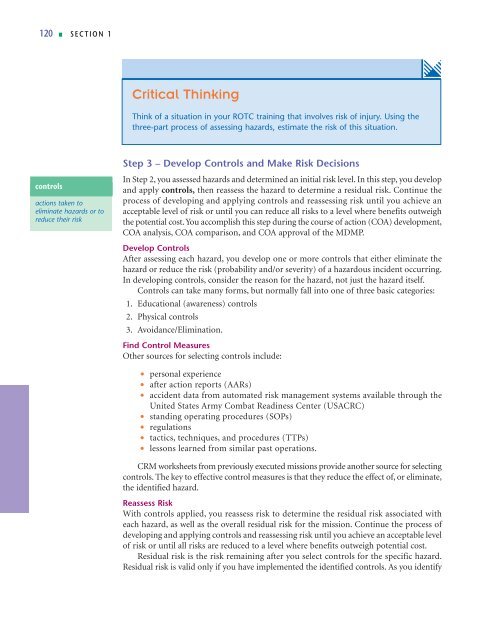Composite Risk Management.pdf - UNC Charlotte Army ROTC
Composite Risk Management.pdf - UNC Charlotte Army ROTC
Composite Risk Management.pdf - UNC Charlotte Army ROTC
- No tags were found...
Create successful ePaper yourself
Turn your PDF publications into a flip-book with our unique Google optimized e-Paper software.
120 ■ SECTION 1Critical ThinkingeThink of a situation in your <strong>ROTC</strong> training that involves risk of injury. Using thethree-part process of assessing hazards, estimate the risk of this situation.Step 3 – Develop Controls and Make <strong>Risk</strong> Decisionscontrolsactions taken toeliminate hazards or toreduce their riskIn Step 2, you assessed hazards and determined an initial risk level. In this step, you developand apply controls, then reassess the hazard to determine a residual risk. Continue theprocess of developing and applying controls and reassessing risk until you achieve anacceptable level of risk or until you can reduce all risks to a level where benefits outweighthe potential cost. You accomplish this step during the course of action (COA) development,COA analysis, COA comparison, and COA approval of the MDMP.Develop ControlsAfter assessing each hazard, you develop one or more controls that either eliminate thehazard or reduce the risk (probability and/or severity) of a hazardous incident occurring.In developing controls, consider the reason for the hazard, not just the hazard itself.Controls can take many forms, but normally fall into one of three basic categories:1. Educational (awareness) controls2. Physical controls3. Avoidance/Elimination.Find Control MeasuresOther sources for selecting controls include:• personal experience• after action reports (AARs)• accident data from automated risk management systems available through theUnited States <strong>Army</strong> Combat Readiness Center (USACRC)• standing operating procedures (SOPs)• regulations• tactics, techniques, and procedures (TTPs)• lessons learned from similar past operations.CRM worksheets from previously executed missions provide another source for selectingcontrols. The key to effective control measures is that they reduce the effect of, or eliminate,the identified hazard.Reassess <strong>Risk</strong>With controls applied, you reassess risk to determine the residual risk associated witheach hazard, as well as the overall residual risk for the mission. Continue the process ofdeveloping and applying controls and reassessing risk until you achieve an acceptable levelof risk or until all risks are reduced to a level where benefits outweigh potential cost.Residual risk is the risk remaining after you select controls for the specific hazard.Residual risk is valid only if you have implemented the identified controls. As you identify
















